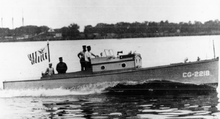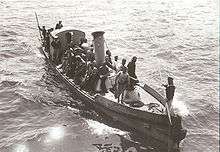Picket boat
A picket boat is a type of small naval craft. These are used for harbor patrol and other close inshore work, and have often been carried by larger warships as a ship's boat. They range in size between 30 and 55 feet.

Patrol boats, or any craft engaged in sentinel duty, are sometimes referred to as picket boats, using "picket" in the generic sense, even if much larger than actual picket boats.
United States
The Union's 45-foot (14 m) long steam-powered Picket Boat Number One sank the Confederate ironclad Albemarle in 1864. (Although named "Picket Boat", this craft has also been called a steam launch). The boat was armed with a 12-pounder Dahlgren gun and a spar torpedo, of which the latter was employed in sinking Albemarle.[1][2] The Union's Potomac Flotilla also employed some picket boats.
A number of American warships of the 19th century carried picket boats, such as the USS Vulcan (her picket boat was heavily engaged by Spanish small-caliber shore fire during one incident in the Spanish–American War), and others.
In the early 1920s, during Prohibition, the United States Coast Guard built a fleet of picket boats to intercept rum runners, supplementing the larger and more seaworthy cutters and patrol boats. These boats were about 36 feet (11 m) long, had no main fixed armament, and cost about US$8,800 (about $131,282[3] in 2019 dollars) to build.[4]
A later picket boat, built between 1932 and 1943, was 38 feet (12 m) long and also had no large main armament.[5]
Britain

A long-serving 19th-century British picket boat, carried on capital ships, was a 50-foot (15 m) model introduced in 1867 which saw wide service in World War I and even some limited service in World War II. The typical main armament during most of this boat's service life was a Hotchkiss 3–pounder, adopted by the Royal Navy in 1886.[6]
British pre-dreadnoughts, including HMS Majestic and HMS Triumph, carried picket boats.[7]
The P1000 Class Picket Boat is a current British Royal Navy boat, 42 feet (13 m) in length, formerly carried on destroyers but now used only for training.[8]
Germany
The Königsberg–class cruisers of 1905 and 1915 carried a picket boat; the Königsbergs of 1927 carried two. The Dresden class of a similar era carried one, as did the Wiesbaden–class.
Larger ships also carried picket boats: The Nassau–, König–, and Bayern–class battleships, the SMS Seydlitz, and the Derfflinger–class battlecruisers all carried one each.
See also
- Launch, a type which overlaps somewhat with picket boats
- Radar picket, a larger ship or submarine, used to extend the range of radar coverage.
References
- Gary P. Priolo. "Picket Boat Number One". NavSource Naval History – NavSource Online: "Old Navy" Ship Photo Archive. Retrieved December 28, 2015.
- "MS2261 – USN Picket Boat #1". Cast Your Anchor Hobby website. Retrieved December 28, 2015.
- Federal Reserve Bank of Minneapolis. "Consumer Price Index (estimate) 1800–". Retrieved January 1, 2020.
- "36–Foot Picket Boat (Open–Cockpit and Double–Cabin)" (PDF). United States Coast Guard. Retrieved December 28, 2015.
- Tim Dring. "Cabin Picket Boat (38ft.)". U.S. Life-Saving Service and U.S. Coast Guard Rescue Craft History. Retrieved December 28, 2015.
- Richard Kemp. "New 28mm Royal Navy Picket Boat from HLBS". The Miniatures Page. Retrieved December 28, 2015.
- Stapleton, N. B. J. (1980). Steam Picket Boats and Other Small Steam Craft of the Royal Navy. UK: Dalton. ISBN 0-900963-63-8.CS1 maint: ref=harv (link)
- James Saumarez (December 2010). "Power Boat Training At Britannia Royal Naval College". SW Soundings. South West Maritime History Society. Archived from the original on June 19, 2012. Retrieved December 28, 2015.